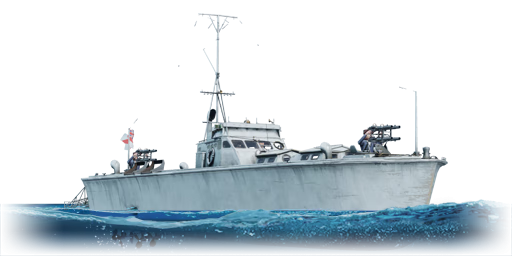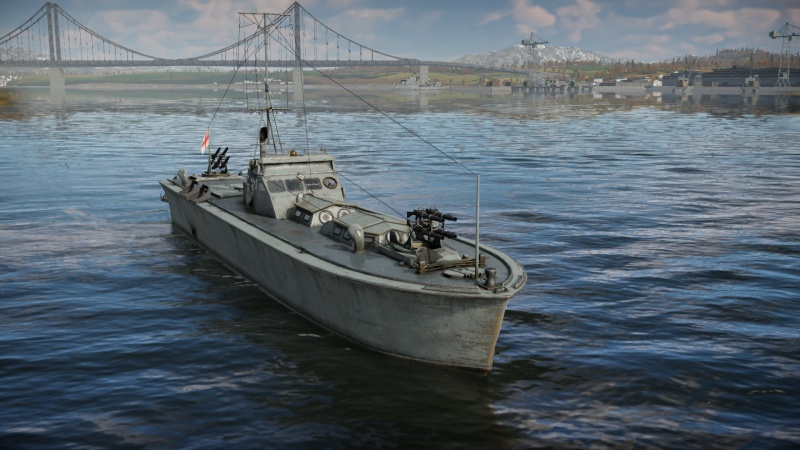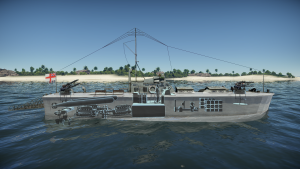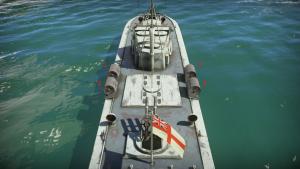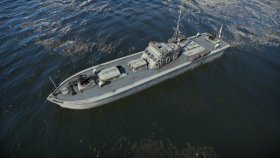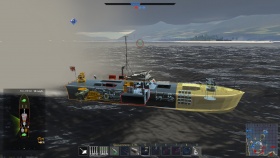Difference between revisions of "MTB-1(1)"
(Updated Armament to 2.5; removed extraneous/incorrect info; reverted to standard torpedo characteristics table; "loadout" -> "setup") |
(Rewrote Usage in battles: removed gimmick playstyle (vehicle actually performs worse in this role than others); removed inccorect/gimmick pros/cons; removed in-game comparison from History section, moved image to Media section) |
||
| Line 210: | Line 210: | ||
[[File:MTB-1_1_series_skin_"MTB-1_'01'".png|thumb|MTB-1 1 series with the historical camouflage '''"MTB-1 '01'''', available on the [http://trade.gaijin.net Gaijin Marketplace].]] | [[File:MTB-1_1_series_skin_"MTB-1_'01'".png|thumb|MTB-1 1 series with the historical camouflage '''"MTB-1 '01'''', available on the [http://trade.gaijin.net Gaijin Marketplace].]] | ||
| − | + | Like any other vessel armed only with low-calibre machineguns, MTB-1 1 series is severely limited by her armament. The 7.72 mm Lewis 1916 machineguns have both a poor muzzle velocity and a low projectile mass, giving them a very low absolute maximum range of only about 1.7 km. Their effective range is even less at only about 1-1.25 km, since the poor ballistics of the guns makes it rather difficult to consistently hit moving targets at any further distance. Being able to consistently hit targets is especially important with MTB-1 1 series as, although she carries a large number of guns, each individual machinegun has an incredibly low per-hit damage output, leaving the overall damage output less than that of her heavy-machinegun or autocannon-armed counterparts. Because of this, along with the range limitation of the guns, MTB-1 1 series is best played at close ranges, with engagement distances ideally starting at 1 km or less. At such short ranges, the poor ballistics of the guns aren't nearly as pronounced, making them much easier to aim. | |
| − | + | Make use of MTB-1 1 series' relatively fast top speed and terrain cover to either flank the enemy team or to rush into contested areas around capture points, but avoid long, open areas of the map wherever possible. In those areas, MTB-1 1 series will most likely be completely outranged, giving giving the enemy free hits. Once in close range, try to avoid direct engagements with enemies, as MTB-1 1 series will most likely lose. Instead, try to flank, supporting the team by picking off small targets distracted by teammates and calling artillery on larger enemies that the guns are are unable to damage. | |
| − | + | Although she can mostly handle one-on-one engagements, MTB-1 1 series is particularly poor at dealing with multiple enemies at once. This is because of the low damage output and extremely long reload. At all times, be aware of the how much ammo are left in the guns. Getting caught during a reload will almost always lead to MTB-1 1 series' destruction, so always keep an escape route open, and use to run away if necessary. In general, but especially for vessels with long reloads, it's better to be proactive with the reloads. Before the magazines empty, run back to cover using smoke, then fire off any remaining ammunition in order to start reloading in safety. A good time to consider doing this with MTB-1 1 series is when the magazines about half empty, or when it shows about 750 rounds left between all guns, since with any less ammo, it may be difficult to defeat certain enemies before needing to reload. However, do be aware that MTB-1 1 series can, at most, only carry enough ammunition for 10 reloads. This doesn't tend to be much of an issue in practice because MTB-1 1 series doesn't tend to survive long enough for it to become an issue, but it is something to keep in mind. | |
| − | + | As for torpedoes, either launch them down choke points or prioritize larger, slower targets such as sub-chasers that the guns are ineffective against. If targeting a specific enemy, try to launch them as close to the target as possible to allow them as little time to dodge as possible. However, try to only do this on distracted targets and when other enemies aren't around, since exposing MTB-1 1 series to enemy fire just to launched the torpedoes is generally not worth it. If the situation doesn't present itself, it's better to just mark the target on the map for your teammates, call artillery, then disengage. As mentioned in the previous section, torpedoes are a situational weapon, and taking them at all negatively impacts survivability, so only take them if you prefer the extra utility at the cost of survivability. | |
| − | |||
| − | |||
| − | |||
| − | |||
| − | |||
| − | ' | ||
| − | |||
| − | |||
| − | |||
| − | |||
| − | |||
| − | |||
| − | |||
| − | |||
| − | |||
| − | |||
| − | |||
| − | |||
=== Pros and cons === | === Pros and cons === | ||
| Line 242: | Line 224: | ||
* Relatively large magazine capacity: can destroy most opponents without needing to reload | * Relatively large magazine capacity: can destroy most opponents without needing to reload | ||
| − | * | + | * Good maneuoverability |
| − | |||
| − | |||
| − | |||
| − | |||
'''Cons:''' | '''Cons:''' | ||
| − | * Only armed with | + | * Only armed with low-calibre guns: very poor damage output and limited effective range |
| − | * | + | * Very long reload: longest of any reserve and one of the longest among coastal vessels |
| − | * | + | * Poor survivability |
| − | * Relatively weak torpedoes | + | * Relatively weak torpedoes: low explosive mass compared to other similar torpedoes |
| − | |||
== History == | == History == | ||
| Line 268: | Line 245: | ||
The 2nd MTB Flotilla was commissioned in 1938 and assigned to HMS Tamar, Hong Kong. They were all lost during the Battle of Hong Kong in December 1941. MTB 8 was bombed by IJN aircraft and was damaged beyond repair, and MTB 12 was sunk in action by IJN landing craft. The remainder of the 2nd MTB Flotilla was scuttled on 26th December 1941. | The 2nd MTB Flotilla was commissioned in 1938 and assigned to HMS Tamar, Hong Kong. They were all lost during the Battle of Hong Kong in December 1941. MTB 8 was bombed by IJN aircraft and was damaged beyond repair, and MTB 12 was sunk in action by IJN landing craft. The remainder of the 2nd MTB Flotilla was scuttled on 26th December 1941. | ||
| − | |||
| − | |||
| − | |||
| − | |||
| − | |||
| − | |||
| − | |||
| − | |||
| − | |||
| − | |||
| − | |||
| − | |||
| − | |||
| − | |||
| − | |||
| − | |||
== Media == | == Media == | ||
| Line 289: | Line 250: | ||
<gallery mode="nolines" widths="280px"> | <gallery mode="nolines" widths="280px"> | ||
| + | Mtb-1 1 series.png|326x326px|MTB-1 1 series in the hangar | ||
MTB-1 damaged-1.jpg|326x326px|MTB-1 1 series defends a capture point, despite numerous damages. | MTB-1 damaged-1.jpg|326x326px|MTB-1 1 series defends a capture point, despite numerous damages. | ||
</gallery> | </gallery> | ||
Revision as of 09:31, 25 February 2021
| This page is about the British motor torpedo boat MTB-1(1). For other versions, see MTB-1 (Family). |
Contents
Description
The MTB-1 1 series is a rank I British motor torpedo boat with a battle rating of 1.0 (AB/RB/SB). It was introduced in Update 1.83 "Masters of the Sea" as part of the British fleet closed beta test. With the split of the naval tech trees in Update "New Power", MTB-1(1) was moved to the Coastal fleet tech tree where it is now the reserve vehicle.
Decently fast and manoeuvrable, MTB-1 1 series is the Reserve vehicle of the British Coastal fleet tech tree. It carries a pair of torpedoes and sports a large number of guns, eight 7.72 mm Lewis 1916 machineguns in total. However, each machinegun individually has a poor damage output and a low effective range, so combined with her low survivability, extra caution is needed to fully utilize MTB-1(1).
General info
Survivability and armour
MTB-1 1 series has the following armour layout:
- Hull: 24 mm, wood
- Superstructure: 2 mm, steel
Any gun in the game will easily be able to penetrate the hull and superstructure at any practical range.
The hull is split into three sections. The first section starts at the bow and ends after the ammunition storage; the second ends just behind the bridge; and the third ends at the stern. MTB-1 1 series can be hull-broken by any round with a large enough diameter and explosive mass. In general, this is limited to HE rounds greater with a diameter greater than 4 inches (102 mm). At MTB-1 1 series' battle rating, there is only one gun capable of hull-breaking her:
- the 8cwt QF Mk I, found on Dark Adventurer.
There is one ammunition storage that holds ammunition for both the fore and aft gun turrets. It is located directly behind the forward gun turret just above the waterline. Destroying it will instantly destroy the boat.
MTB-1 1 series has a crew complement of 11. With a stock crew, vehicle is knocked out when 7 crew are lost; with an aced crew, this is increased to 8.
Compared to other reserve coastal vessels, the crew complement is average. However, due to her gun placements and size, MTB-1 1 series cannot take advantage of her survivability nearly as well as some of the other reserves, making her one of the least survivable. When compared to non-reserve vessels, her survivability is rather poor.
Mobility
| Mobility Characteristics | |||||
|---|---|---|---|---|---|
| Game Mode | Upgrade Status | Maximum Speed (km/h) | Turn Time (s) | Turn Radius (m) | |
| Forward | Reverse | ||||
| AB | Stock | 63 | 32 | ~18.64 | ~35.43 |
| Upgraded | 86 | 43 | ~12.67 | ~22.41 | |
| RB/SB | Stock | 53 | 26 | ~20.77 | ~36.73 |
| Upgraded | 61 | 31 | ~17.44 | ~33.15 | |
While her top speed is on the slower side compared to other motor torpedo boats, MTB-1 1 series' manoeuvrability is actually rather good. With a tight turning circle and a decent enough top speed, the mobility is suitable enough for most situations, although the lower top speed really hurts her potential for flanking on certain maps.
MTB-1 1 series has a displacement of 22.4 tons. Because of her small size and relatively low displacement, MTB-1 1 series can be an unstable firing platform in rough waters.
Modifications and economy
As a reserve vehicle, the following modifications are unlocked for free: Rudder Replacement, Propeller Replacement, Engine Maintenance, Tool Set, Fire Protection System, New Pumps, and Primary Armament Targeting.
The recommended modification research order is:
- 7.7 mm AP belt
- Smokescreen
- Artillery Support
- Dry-Docking
After that, research the rest of the modifications in whatever order you prefer.
Armament
Primary armament
The primary armament consists of eight 7.72 mm Lewis 1916 machineguns in two quadruple mounts, one on the bow and one on the stern. There are 3,880 rounds of ammunition available for each mount, 970 rounds per gun, for a total of 7,760 rounds. Stock, the mounts can traverse horizontally and vertically at a rate of 64°/s; with the "Primary Armament Targeting" modification installed, this is increased to 75°/s. Each gun has a magazine capacity of 97 rounds and a cyclic rate of fire of 551 rounds/min. With a stock crew, the guns can be reloaded in 18.2 seconds; with an aced crew, they can be reloaded in 14 seconds. The 7.72 mm Lewis 1916 machinegun has an absolute maximum range of about 1.7 km against surface targets.
The 7.72 mm Lewis 1916 machineguns, like other low-calibre machineguns, each individually have very poor damage outputs. With their relatively large magazine size and eight of them in total, though, MTB-1 1 series is able to destroy most opponents without needing to reload, assuming that most of the shots land. This, however, comes at the cost of an incredibly long reload, the longest of any reserve vessel and one of the longest of any coastal fleet vessel in general. Because of this, it's best to always fire off any remaining ammunition after engagements to begin reloading in safety and to ensure full magazines at the start of the next engagement.
| Turrets are named sequentially, clockwise, starting at the bow |
| Primary Armament Guidance | |||
|---|---|---|---|
| No.1 Turret (fore) | No.2 Turret (aft) | ||
| Horizontal | Vertical | Horizontal | Vertical |
| ±180° | -5°/+43° | ±160° | -5°/+43° |
The front gun mount is able to fire in all directions except in a ~34° arc directly behind it. Because of the depth charge racks, the aft gun mount is unable to target any close-range targets in a ~42° arc on each side facing forwards, even if the depth charge racks are empty. The rear gun mount also cannot fire in a ~30° arc directly behind either.
There are three ammunition types available:
- Universal: AP · T · AP · T
- 7.7 mm AP belt: AP · AP · AP · T
- 7.7 mm API belt: IT · IT · IT · AP
| Penetration Statistics | ||||||
|---|---|---|---|---|---|---|
| Ammunition | Penetration @ 0° Angle of Attack (mm) | |||||
| 10 m | 100 m | 500 m | 1,000 m | 1,500 m | 2,000 m | |
| Universal | 10 | 9 | 8 | 7 | 6 | 5 |
| 7.7 mm AP belt | 10 | 9 | 8 | 7 | 6 | 5 |
| 7.7 mm API belt | 10 | 9 | 7 | 6 | 5 | 5 |
Within all of the belts, the AP round is the main damage dealer. The T round deals very little damage to both surface targets and aircraft, only really being useful as a guide for aiming. As a result, the AP belt, with its 3:1 ratio of AP:T rounds, is the most effective in all situations. The Universal belt, with its 1:1 ratio of AP:T rounds, is a direct downgrade from the AP belt in terms of damage and should be replaced by the AP belt as soon as it's unlocked. While the API belt, comprising wholly of IT rounds, may initially seem like the best option due to the incendiary effect of the IT rounds, the IT round in practice is actually comparable to the T round in damage, rarely starting fires and doing incredibly little damage against surface targets. Against aircraft, the difference in damage between the AP belt and the API belt is negligible.
Additional armament
MTB-1(1) has four setups:
- 2 x Mk.XII torpedo
- 4 x Mk.VII depth charge
- 2 x Mk.XII torpedo, 4 x Mk.VII depth charge
- Without load
Torpedoes
MTB-1 1 series can carry two 18 inch Mark XII torpedoes. These are carried internally in the aft of the boat and are launched through the transom tail first, i.e. facing forwards.
| Torpedo Characteristics | ||||||||
|---|---|---|---|---|---|---|---|---|
| Torpedo Mode | Mass (kg) | Maximum speed in water (km/h) | Travel distance (km) | Depth stroke (m) | Arming distance (m) | Explosive type | Explosive mass (kg) | TNT equivalent (kg) |
| No | 1559 | 83 | 5.50 | 1 | 50 | TNT | 224 | 224 |
| Yes | 1559 | 107 | 3.67 | 1 | 50 | TNT | 224 | 224 |
The 18-inch Mk.XII is fairly average in terms of maximum speed and range, though it has a rather small explosive mass compared to other torpedoes. Still, a hit with the Mk.XII torpedo is more than enough to destroy any boat. Besides that, this torpedo is unnoteworthy.
The Torpedo Mode modification is available as a rank IV modification. Installing it will give the following changes:
| Torpedo Mode Specification Changes | |
|---|---|
| Max Distance (m) | Max Speed (m/s) |
| -1829 | +7 |
Once unlocked, it's best to always keep Torpedo Mode installed. The maximum speed of a torpedo is much of valuable in coastal battles than its maximum range. Coastal fleet maps are also small enough that the decreased range with Torpedo Mode installed isn't much of an issue. Note, though, that the Torpedo Mode modification on MTB-1 1 series has the opposite effect compared to most other vessels. Typically, the maximum range is increased at the cost of speed.
In RB, always set the depth stroke to the minimum 1 m setting. This is because many vessels that MTB-1 1 series can face will not have a deep enough draught to fuze the torpedo at a depth stroke setting of 4 m. In AB, depth stroke is automatically set to the most optimal setting.
When using torpedoes, be aware that unless they are already launched, the torpedoes be shot at and destroyed. Upon being destroyed, there is relatively high chance for them to detonate, instantly destroying the boat. To avoid this, fire the torpedoes early on in battle — as well as after any subsequent reloads in AB — or simply don't take them at all. Torpedoes are a situational weapon, so it's largely down to personal preference whether or not to take them.
Depth Charges
The Mk.VII depth charges are carried behind the bridge in racks, two on each side. They are dropped one at a time in the following order:
- Port, foremost
- Starboard, foremost
- Port, aftmost
- Starboard, aftmost
Before spawning, the detonation time delay can be set anywhere between 3 seconds and 10 seconds.
| Depth Charge Characteristics | |||
|---|---|---|---|
| Mass (kg) | Explosive Type | Explosive Mass (kg) | TNT Equivalent (kg) |
| 196 | TNT | 130 | 130 |
There is almost no practical reason to use depth charges on any naval vessel in the game. Although they usually result in a one-hit kill if used properly, they are extremely situational, requiring the player to close to point-blank ranges to even use them. In almost every case, anytime a depth charge could be used, the guns or torpedoes can be used instead to greater effect. In fact, depth charges tend to actually be a liability in battle, since they essentially act as exposed ammo racks before they're dropped. Like torpedoes, they can be shot at, and if destroyed, they have a chance to detonate, instantly destroying the boat.
Despite this, some success can be had in dropping them very close to a slower opponent. When doing this, remember the depth charge drop order, since most likely, only the depth charges dropped on the side closed to the enemy will deal any damage. Additionally set the depth charge time delay to the minimum 3 seconds, since any higher time delay only depth charge to sink further away from the target, giving them more time to move out of the way. Again, using depth charges is extremely situational, and they will only be a liability the vast majority of the time, so take them at your own discretion.
Usage in battles
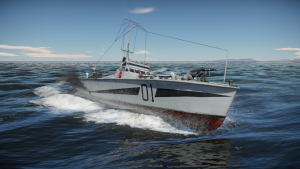
Like any other vessel armed only with low-calibre machineguns, MTB-1 1 series is severely limited by her armament. The 7.72 mm Lewis 1916 machineguns have both a poor muzzle velocity and a low projectile mass, giving them a very low absolute maximum range of only about 1.7 km. Their effective range is even less at only about 1-1.25 km, since the poor ballistics of the guns makes it rather difficult to consistently hit moving targets at any further distance. Being able to consistently hit targets is especially important with MTB-1 1 series as, although she carries a large number of guns, each individual machinegun has an incredibly low per-hit damage output, leaving the overall damage output less than that of her heavy-machinegun or autocannon-armed counterparts. Because of this, along with the range limitation of the guns, MTB-1 1 series is best played at close ranges, with engagement distances ideally starting at 1 km or less. At such short ranges, the poor ballistics of the guns aren't nearly as pronounced, making them much easier to aim.
Make use of MTB-1 1 series' relatively fast top speed and terrain cover to either flank the enemy team or to rush into contested areas around capture points, but avoid long, open areas of the map wherever possible. In those areas, MTB-1 1 series will most likely be completely outranged, giving giving the enemy free hits. Once in close range, try to avoid direct engagements with enemies, as MTB-1 1 series will most likely lose. Instead, try to flank, supporting the team by picking off small targets distracted by teammates and calling artillery on larger enemies that the guns are are unable to damage.
Although she can mostly handle one-on-one engagements, MTB-1 1 series is particularly poor at dealing with multiple enemies at once. This is because of the low damage output and extremely long reload. At all times, be aware of the how much ammo are left in the guns. Getting caught during a reload will almost always lead to MTB-1 1 series' destruction, so always keep an escape route open, and use to run away if necessary. In general, but especially for vessels with long reloads, it's better to be proactive with the reloads. Before the magazines empty, run back to cover using smoke, then fire off any remaining ammunition in order to start reloading in safety. A good time to consider doing this with MTB-1 1 series is when the magazines about half empty, or when it shows about 750 rounds left between all guns, since with any less ammo, it may be difficult to defeat certain enemies before needing to reload. However, do be aware that MTB-1 1 series can, at most, only carry enough ammunition for 10 reloads. This doesn't tend to be much of an issue in practice because MTB-1 1 series doesn't tend to survive long enough for it to become an issue, but it is something to keep in mind.
As for torpedoes, either launch them down choke points or prioritize larger, slower targets such as sub-chasers that the guns are ineffective against. If targeting a specific enemy, try to launch them as close to the target as possible to allow them as little time to dodge as possible. However, try to only do this on distracted targets and when other enemies aren't around, since exposing MTB-1 1 series to enemy fire just to launched the torpedoes is generally not worth it. If the situation doesn't present itself, it's better to just mark the target on the map for your teammates, call artillery, then disengage. As mentioned in the previous section, torpedoes are a situational weapon, and taking them at all negatively impacts survivability, so only take them if you prefer the extra utility at the cost of survivability.
Pros and cons
Pros:
- Relatively large magazine capacity: can destroy most opponents without needing to reload
- Good maneuoverability
Cons:
- Only armed with low-calibre guns: very poor damage output and limited effective range
- Very long reload: longest of any reserve and one of the longest among coastal vessels
- Poor survivability
- Relatively weak torpedoes: low explosive mass compared to other similar torpedoes
History
Though the Royal Navy had operated a small number of coastal boats during the first World War, by the 1930s, these flotillas had long been dissolved and the Royal Navy had yet to construct any more. The first two coastal boats since WWI were ordered on 27th September 1935 by the Royal Navy, the order being given to British Power Boat Company based at Hythe, a town near Southampton. In addition to this initial order, four more were ordered on 19th October 1935. These six boats were completed by November 1936, and, with their commissioning on 27th April 1937, the Royal Navy Coastal Forces was founded. Following this, three more boats were ordered on 7th December 1936 and nine more on 11th January 1938. In total, 18 boats were ordered, all of them being completed by 1939.
These boats had a standard displacement of 18 tons and had a length of 60 ft. 4 in., a width of 13 ft. 4 in., and a drought of 2 ft. 10 in. at standard displacement. They were powered by three Napier Sea Lion petrol engines, each driving a single shaft, and could reach speeds of around 30-35 knots. Each boat could carry two 18 inch torpedoes which were stored internally on rails above the engines. On the stern were two more rails that could be folded down to the transom, extending the torpedoes' rails outside of the boat. The torpedoes fired facing forwards down the rails, after which the boat that fired them would have to turn to evade their path. In addition to torpedoes, the boats were also armed with a number of depth charges and, depending on the exact boat, up to eight Lewis guns.
MTB 1, the first of the boats, was redesignated MTB 7 in 1937. Similarly, MTB 7 was redesignated MTB 1 in the same year. In 1938, the former MTB 1, now MTB 7, was redesignated MTB 13. At the same time, MTB 13 was redesignated MTB 7. Finally, later in 1938, the former MTB 1, now MTB 13, was again redesignated MTB 19. Thus, by the start of WWII, the boats were numbered MTBs 1-12 and 14-19 and formed two MTB flotillas: 1st MTB Flotilla, consisting of MTBs 1-6 and 14-19; and 2nd MTB Flotilla, consisting of MTBs 7-12.
The 1st MTB Flotilla was sent to the Mediterranean at the start of WWII and was based at HMS Vulcan in Malta. They were soon recalled back to England in December 1939 to be based at HMS Beehive, Felixstowe, though MTB 19 was sent to HMS Vernon, Portsmouth. Along the way back, due to bad weather, MTB 6 had to be foundered. After they arrived, the remaining boats continued to operate in the English Channel until they were either lost or replaced. Those lost were MTBs 15, 16, and 17, all of which were mined in 1940.
The 2nd MTB Flotilla was commissioned in 1938 and assigned to HMS Tamar, Hong Kong. They were all lost during the Battle of Hong Kong in December 1941. MTB 8 was bombed by IJN aircraft and was damaged beyond repair, and MTB 12 was sunk in action by IJN landing craft. The remainder of the 2nd MTB Flotilla was scuttled on 26th December 1941.
Media
See also
- Similar class/series
- Other contemporary British boats
External links
- [Wikipedia] Coastal Forces of the Royal Navy
- [Unit Histories] Royal Navy Coastal Forces 1940-1945
- [Naval History] British vessels lost at sea in World War 2 - MGB, MTB, SGB, ML, etc - originally published in British Vessels Lost at Sea, 1935-45, His Majesty's Stationary Office, 1947
- [mwadui.com] Royal Navy Coastal Forces - Hong Kong
- [Coastal Forces] Coastal Forces of World War II - History
- [yalumba.co.uk] British Power Boat Co Page 1
- [yalumba.co.uk] British Power Boat Co Page 5
| Britain boats | |
|---|---|
| Motor torpedo boats | Brave Borderer · Dark Aggressor · Dark Aggressor TD · Fairmile D (617) · Fairmile D (697) · Fairmile D (5001) · HMS Gay Archer |
| MTB-1(1) · MTB-1(2) · MTB Vosper · MTB Vosper(2) · MTB-422 | |
| Motor gun boats | Dark Adventurer · Fairmile A (ML100) · Fairmile B (ML345) · Fairmile C (312) · Fairmile C (332) · Fairmile D (601) · Fairmile H LCS(L)(2) |
| HMAS Arrow · MGB-61 · MGB-75 · ML 1383 · SGB Grey Fox · SGB Grey Goose | |
| Gunboats | HMS Spey |


